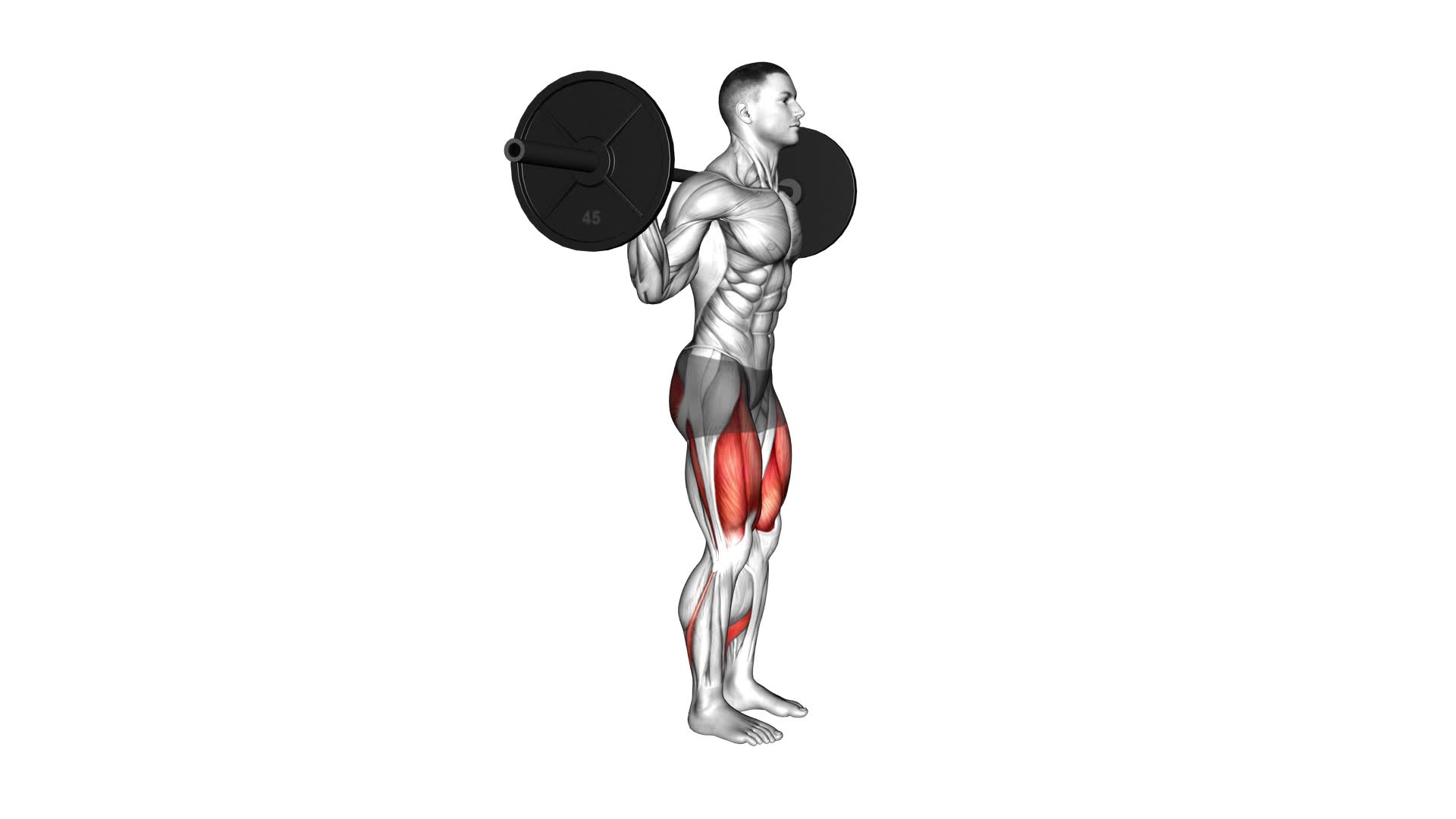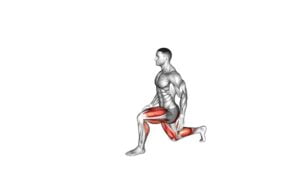Barbell Walking Lunge – Video Exercise Guide & Tips

Looking to up your leg workout game? Check out this video exercise guide on the Barbell Walking Lunge.
Watch This Exercise Video
In just a few minutes, you'll learn proper form, common mistakes to avoid, and variations to increase intensity.
Whether you're a beginner or a seasoned pro, incorporating this exercise into your routine will help you build strength and improve your overall fitness.
So grab a barbell, get ready to lunge, and let's get those legs burning!
Key Takeaways
- Barbell walking lunges engage multiple muscles in the lower body
- Proper form and technique include maintaining a firm grip on the barbell and keeping an upright posture
- Common mistakes to avoid include allowing the knee to extend past the toes and not engaging the core for stability
- Injury prevention techniques include proper warm-up, gradual increase in intensity and weight, and maintaining control during the exercise
Benefits of the Barbell Walking Lunge
You will experience numerous benefits from incorporating barbell walking lunges into your workout routine. One of the key benefits of weighted lunges is the muscle activation they provide. When you perform barbell lunges, you engage several muscles in your lower body, including your quadriceps, hamstrings, glutes, and calves. By carrying the weight on your shoulders and walking forward, you challenge these muscles to work together, resulting in improved strength and stability.
Weighted lunges also help to improve your balance and coordination. As you step forward and lower your body into the lunge position, you're required to maintain control and stability. This not only strengthens your muscles but also enhances your overall balance and coordination.
Furthermore, barbell lunges can be an effective exercise for building strength and power. By adding resistance to your lunges, you increase the intensity of the exercise, forcing your muscles to work harder. This can lead to gains in strength and power, which can be beneficial for various sports and activities.
Incorporating barbell walking lunges into your routine not only provides these benefits but also serves as a great warm-up exercise for your lower body.
Now, let's move on to discussing proper form and technique to ensure you get the most out of this exercise.
Proper Form and Technique
To ensure proper form and technique while performing barbell walking lunges, use a firm grip on the barbell. This will help you maintain control and stability throughout the exercise. When performing the lunge, start by standing with your feet hip-width apart and the barbell resting on your upper back. Take a step forward with one leg, bending both knees until your back knee is just above the ground. Make sure to keep your front knee directly above your ankle and your back knee pointing down towards the ground. Push off with your front foot to return to the starting position and then repeat the movement with the other leg.
Proper form demonstration is crucial when performing barbell walking lunges. It's important to maintain an upright posture throughout the exercise, keeping your chest lifted and shoulders back. Avoid leaning forward or rounding your back, as this can put unnecessary strain on your spine.
By using proper form and technique, you can maximize the benefits of lunges for strength training. Lunges are an excellent exercise for targeting the quadriceps, hamstrings, glutes, and calves. They also help improve balance, stability, and coordination.
Incorporating lunges into your strength training routine can help you build lower body strength and power, improve athletic performance, and enhance overall functional fitness.
Common Mistakes to Avoid
When performing barbell walking lunges, it's important to be aware of common mistakes that can hinder your progress and potentially lead to injury. By focusing on form correction tips, such as keeping your core engaged and maintaining proper alignment, you can ensure that you're maximizing the benefits of this exercise while minimizing the risk of injury.
Additionally, incorporating injury prevention techniques, such as starting with lighter weights and gradually increasing the load, can help you avoid overexertion and strain.
Form Correction Tips
To correct your form during the barbell walking lunge, regularly assess your technique and make adjustments as needed. Proper form is crucial to maximize the effectiveness of this exercise and prevent injuries.
One common mistake to avoid is allowing your knee to extend past your toes when stepping forward. Instead, focus on taking a long stride while keeping your knee directly above your ankle.
Another mistake is leaning too far forward, which places excessive strain on your lower back. Maintain an upright posture throughout the movement, engaging your core for stability.
Additionally, be mindful of your foot placement to avoid wobbling or losing balance.
By correcting these form errors, you can perform the barbell walking lunge with precision and efficiency, reducing the risk of injury.
Now, let's move on to the next section about injury prevention techniques.
Injury Prevention Techniques
To prevent injuries during the barbell walking lunge, regularly assess your technique and make necessary adjustments, focusing on maintaining proper form and avoiding common mistakes. Injury prevention techniques are essential to ensure a safe and effective workout.
Firstly, always warm up properly before starting the exercise to prepare your muscles and joints for the movement. Additionally, listen to your body and avoid pushing yourself too hard, especially if you're a beginner. Start with lighter weights and gradually increase the intensity as you become more comfortable and confident.
It's also important to maintain proper alignment throughout the exercise, keeping your chest up, shoulders back, and core engaged. Lastly, avoid rushing through the movement and maintain control to minimize the risk of injury.
By following these injury prevention techniques, you can safely and effectively perform barbell walking lunges without compromising your form or risking injury.
Now, let's move on to discussing variations to increase intensity.
Variations to Increase Intensity
One way to increase the intensity of the barbell walking lunge is by incorporating added resistance. This can be done in several ways to challenge your muscles and take your workout to the next level.
Here are some advanced modifications you can try:
- Dumbbell Walking Lunges: Instead of using a barbell, hold a dumbbell in each hand. This will require more stability and control, as well as engage your core muscles to a greater extent.
- Weighted Vest: Wear a weighted vest while performing the walking lunges. This will add resistance to your entire body, making the exercise more challenging and increasing the difficulty level.
- Barbell Front Rack Walking Lunges: Place the barbell on the front of your shoulders, with your elbows pointing forward. This variation targets your quads and core muscles even more, giving you an extra challenge.
- Barbell Overhead Walking Lunges: Hold the barbell overhead, with your arms fully extended. This variation not only strengthens your lower body but also engages your shoulder muscles and improves your overall stability.
Incorporating these variations into your barbell walking lunges will help you increase the difficulty of the exercise and continue to progress in your fitness journey. Remember to always maintain proper form and listen to your body to avoid any injuries.
Tips for Incorporating the Barbell Walking Lunge Into Your Workout Routine
To effectively incorporate the barbell walking lunge into your workout routine, it's crucial to focus on proper form techniques. This includes keeping your chest up, shoulders back, and engaging your core throughout the movement.
Lunges offer numerous benefits such as strengthening your lower body muscles, improving balance, and increasing flexibility.
Additionally, there are variations of lunges available to suit all fitness levels, allowing you to gradually progress and challenge yourself.
Proper Form Techniques
When performing the Barbell Walking Lunge, ensure proper form by maintaining a strong core and engaging your leg muscles throughout the exercise. To help you incorporate this exercise into your workout routine, here are some tips:
- Keep your chest up and shoulders back to maintain good posture.
- Take long strides forward, ensuring that your knee doesn't extend past your toes.
- Lower your back knee towards the ground, aiming for a 90-degree angle between your thigh and calf.
- Push through your front heel to return to the starting position.
By following these guidelines, you can maximize the benefits of the Barbell Walking Lunge. This exercise targets your glutes, quadriceps, and hamstrings, helping to build strength and stability in your lower body. Additionally, it can be modified to suit your fitness level by adjusting the weight or using dumbbells instead of a barbell.
Remember to start with lighter weights and gradually increase as you become more comfortable and confident in your form.
Benefits of Lunges
To maximize the benefits of lunges and incorporate the Barbell Walking Lunge into your workout routine, focus on maintaining proper form and gradually increasing the weight as you become more comfortable and confident in your execution.
Lunges are an excellent exercise for targeting the glutes, as they activate these muscles with each step you take. By engaging your glutes, lunges can help you build strength and tone in this area.
Additionally, lunges require balance and stability, making them a great exercise for improving these aspects as well. Incorporating the Barbell Walking Lunge into your routine won't only challenge your lower body muscles but also help improve your overall stability and balance.
Variations for All Levels
To incorporate the Barbell Walking Lunge into your workout routine and cater to all fitness levels, choose variations that suit your needs and utilize a range of weights. Here are some modifications and advanced variations to consider:
- Beginner Modifications:
- Start with bodyweight lunges to build strength and stability.
- Use dumbbells instead of a barbell to reduce the load on your legs.
- Perform stationary lunges instead of walking lunges to decrease the difficulty.
- Advanced Variations:
- Increase the weight on the barbell to challenge your muscles further.
- Try adding a knee drive at the top of each lunge to engage your core.
- Incorporate plyometric lunges by adding a jump in between each lunge.
- Perform deficit lunges by standing on an elevated platform to increase the range of motion.
Safety Precautions and Modifications for Beginners
To ensure your safety as a beginner, it's important that you follow certain precautions and modifications when performing the barbell walking lunge exercise.
Safety modifications are necessary to prevent injuries and allow you to gradually build strength and stability. As a beginner, it's recommended to start with bodyweight lunges before adding any weight. This will help you get comfortable with the movement pattern and develop proper form.
Focus on maintaining good posture throughout the exercise, keeping your chest lifted and your core engaged. It's also important to warm up your muscles before attempting the barbell walking lunge. This can be done through dynamic stretching or light cardio exercises.
When you feel ready to progress, start by using a lighter barbell or dumbbells instead of a heavy one. This will allow you to focus on your form without compromising your safety. As you gain strength and confidence, you can gradually increase the weight.
Remember to listen to your body and only progress when you feel ready. By following these beginner modifications and being mindful of your body's limitations, you can safely and effectively perform the barbell walking lunge exercise.
Frequently Asked Questions
How Much Weight Should I Use for the Barbell Walking Lunge?
When it comes to the barbell walking lunge, determining the right weight depends on your fitness level and goals.
It's important to maintain proper form throughout the exercise, so start with a weight that challenges you but allows you to perform the movement correctly.
Gradually increase the weight as you get stronger and more comfortable with the exercise.
Can I Perform the Barbell Walking Lunge Without a Barbell?
Yes, you can perform the barbell walking lunge without a barbell.
There are alternative exercises you can do, such as using dumbbells or kettlebells to add resistance.
However, using a barbell offers certain benefits.
It helps to increase overall strength and stability, as well as targeting the muscles in your legs and glutes more effectively.
It also allows for greater progression and the ability to lift heavier weights over time.
How Many Sets and Repetitions Should I Do for the Barbell Walking Lunge?
To determine the number of sets and repetitions for the barbell walking lunge, you should consider your fitness level and goals. Beginners may start with 2-3 sets of 10-12 reps, gradually increasing as you get stronger.
Incorporating the barbell walking lunge into your leg day routine offers several benefits, such as improved lower body strength, balance, and muscle development.
For beginners, modifying the exercise by using bodyweight or dumbbells can help build strength and proper form.
Is It Necessary to Warm up Before Doing the Barbell Walking Lunge?
It is highly recommended to warm up before doing the barbell walking lunge. Incorporating a warm-up routine before exercise has numerous benefits.
It increases blood flow to the muscles, improves flexibility, and reduces the risk of injury.
If you have knee or hip issues, there are modifications you can make to the barbell walking lunge to avoid discomfort.
Always consult with a fitness professional or physical therapist for personalized guidance.
Can I Do the Barbell Walking Lunge if I Have Knee or Hip Issues?
If you have knee or hip issues, it's important to modify or find alternative exercises to the barbell walking lunge. Putting excessive stress on your joints could worsen your condition.
Instead, focus on exercises that are lower impact and don't involve as much knee and hip flexion, such as step-ups or stationary lunges. These exercises can still target your leg muscles effectively while being gentler on your joints.
Conclusion
Incorporating the barbell walking lunge into your workout routine can provide a range of benefits, including improved lower body strength and stability. By following proper form and technique, you can maximize the effectiveness of this exercise while minimizing the risk of injury.
Avoid common mistakes and consider variations to increase intensity as you progress. Remember to prioritize safety and modify the exercise as needed, especially if you're a beginner.
Start reaping the benefits of the barbell walking lunge today!

Author
Years ago, the spark of my life’s passion ignited in my mind the moment I stepped into the local gym for the first time. The inaugural bead of perspiration, the initial endeavor, the very first surge of endorphins, and a sense of pride that washed over me post-workout marked the beginning of my deep-seated interest in strength sports, fitness, and sports nutrition. This very curiosity blossomed rapidly into a profound fascination, propelling me to earn a Master’s degree in Physical Education from the Academy of Physical Education in Krakow, followed by a Sports Manager diploma from the Jagiellonian University. My journey of growth led me to gain more specialized qualifications, such as being a certified personal trainer with a focus on sports dietetics, a lifeguard, and an instructor for wellness and corrective gymnastics. Theoretical knowledge paired seamlessly with practical experience, reinforcing my belief that the transformation of individuals under my guidance was also a reflection of my personal growth. This belief holds true even today. Each day, I strive to push the boundaries and explore new realms. These realms gently elevate me to greater heights. The unique combination of passion for my field and the continuous quest for growth fuels my drive to break new ground.



